This month Staff Favorites feature the visual art LifeWorks loves. They say a picture is worth a thousand words, and many of us have found that sentiment to be true. Often human experience surpasses language and we are left with visualization, tactile sensation, music, or other forms of art. This month we are sharing the works of art that speak to us in ways that words cannot. As always, please share your favorites in the comments section.
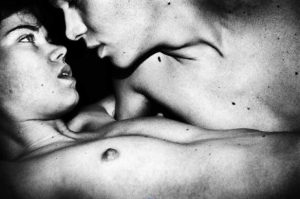 Bridgid O’Connell: Jacob Aue Sobol’s Martin et Pernelle
Bridgid O’Connell: Jacob Aue Sobol’s Martin et Pernelle
It was really difficult for me to choose something that I consider to be a “favorite” art piece. I have always been drawn to photography, and received my BA in photography from Columbia College, Chicago. This is a recent piece I discovered created by Jacob Aue Sobol entitled, Martin et Pernelle, Copenhagen, Denmark, 2010.
This beautiful piece speaks to me through the words of the photographer, himself:
“To me, the camera has always been a tool to find and depict love to a point that it became an obsession. How close can I get to a love that feels true in my images? Is this the love I have been searching for myself these past 20 years? Is this the love of my life? I photographed young couples in love across the planet to remind us that we are all the same, to remind us that what we have in common is greater than what separates us. That young couples in love from Beijing share the same love as young couples from Moscow, Paris or New York. And, even after this obsessive search for love came to an end, I found Martin and Pernille in my own neighborhood in Copenhagen.”
 Joey Allaire: The Aids Memorial Quilt
Joey Allaire: The Aids Memorial Quilt
The AIDS Memorial Quilt weighs 54 tons. Each panel of this massive piece of collaborative art represents the life of someone who died during the AIDS crisis. The AIDS crisis continues to be a lesson in the cross-stitching of power and identity. It is constructed from lace and leather, feathers and crystals, jeans and sequins, condoms and ashes. Lodged in an American folk art tradition and emerging from street activism, the Quilt looks like nothing else. 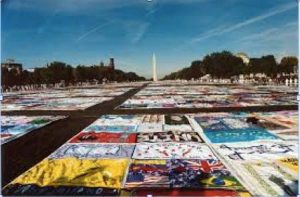 No single artist created the Quilt, it is made by friends, family, caregivers, nurses, fans, lovers of the many who died and die. For a time, the Quilt was laid out on the National Mall covering the heart of the city with these stories. The Quilt is an object where mourning, celebration and imagination are pleated by a hundred thousand hands. It travels around the world in sections, signifying a wholeness that continues to be discovered as new pieces enter the Quilt. Its a place to curl up when the world freezes and imagine a warmer day and its big enough for all of us.
No single artist created the Quilt, it is made by friends, family, caregivers, nurses, fans, lovers of the many who died and die. For a time, the Quilt was laid out on the National Mall covering the heart of the city with these stories. The Quilt is an object where mourning, celebration and imagination are pleated by a hundred thousand hands. It travels around the world in sections, signifying a wholeness that continues to be discovered as new pieces enter the Quilt. Its a place to curl up when the world freezes and imagine a warmer day and its big enough for all of us.
Matt Amador: Broadway Boogie Woogie Mondrian
I saw this when I was in NYC a couple years ago, it’s a Mondrian piece, Broadway Boogie Woogie, that’s been completely re imagined with 1632 spools of thread for Manhattan’s Fashion District. If the original was supposed to evoke the urgency of urban, cosmopolitan life, this re-frames it for the fashion industry. This re-imagining reminds me that nothing in this world is necessarily static; art can change, paradigms can shift, emotions can evolve.
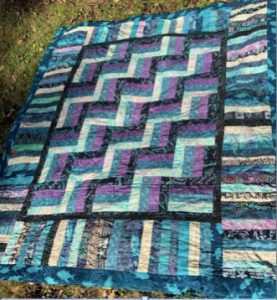 Betsy Duke: Log Cabin Quilt, Boston Commons Quilt by Merry Beth Seward
Betsy Duke: Log Cabin Quilt, Boston Commons Quilt by Merry Beth Seward
The art form I have always been most inspired by is quilting. Not only does it take precision, creativity, and dedication to make a quilt; it is also an art form practiced traditionally by groups of women in order to keep homes and communities sewn together. Pun intended. For generations the art of quilting has facilitated bonding among circles of women, and through that bonding women have found healing, hope, humor, and comfort. This art form is also practical, providing warmth for families, chosen or otherwise.
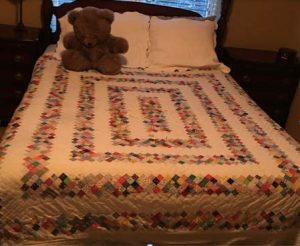 Today quilts can be made by one individual from start to finish, but before the days of sewing machines and precut fabric, people relied on the help of others to complete their family project, envelop their children, protect the sick, and warm their homes.
Today quilts can be made by one individual from start to finish, but before the days of sewing machines and precut fabric, people relied on the help of others to complete their family project, envelop their children, protect the sick, and warm their homes.
The two quilts shown here were made by my mom – in circles with her best friends, her mother, her friends, my friends and partners, her chosen family, and her blood family (Merry Beth Seward, 1985/2004).
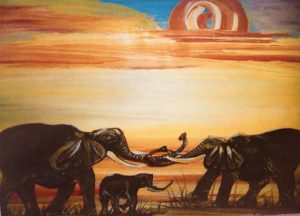 Zac Palmer: Untitled painting, artist unknown
Zac Palmer: Untitled painting, artist unknown
When I was last in Uganda I received this painting and my brother, Tony, told me of an East African proverb: “When two elephants fight, it’s the grass that suffers.” For me in my career as a family therapist, this message is profound — especially when considering children who witness parents fighting. The painting displays the power dynamics and the inter-generational impact of destructive conflict management, and it also speaks to me personally because I resonate with the little elephant’s confusion as it witnesses the chaos of the guardian elephants intertwined in conflict.
